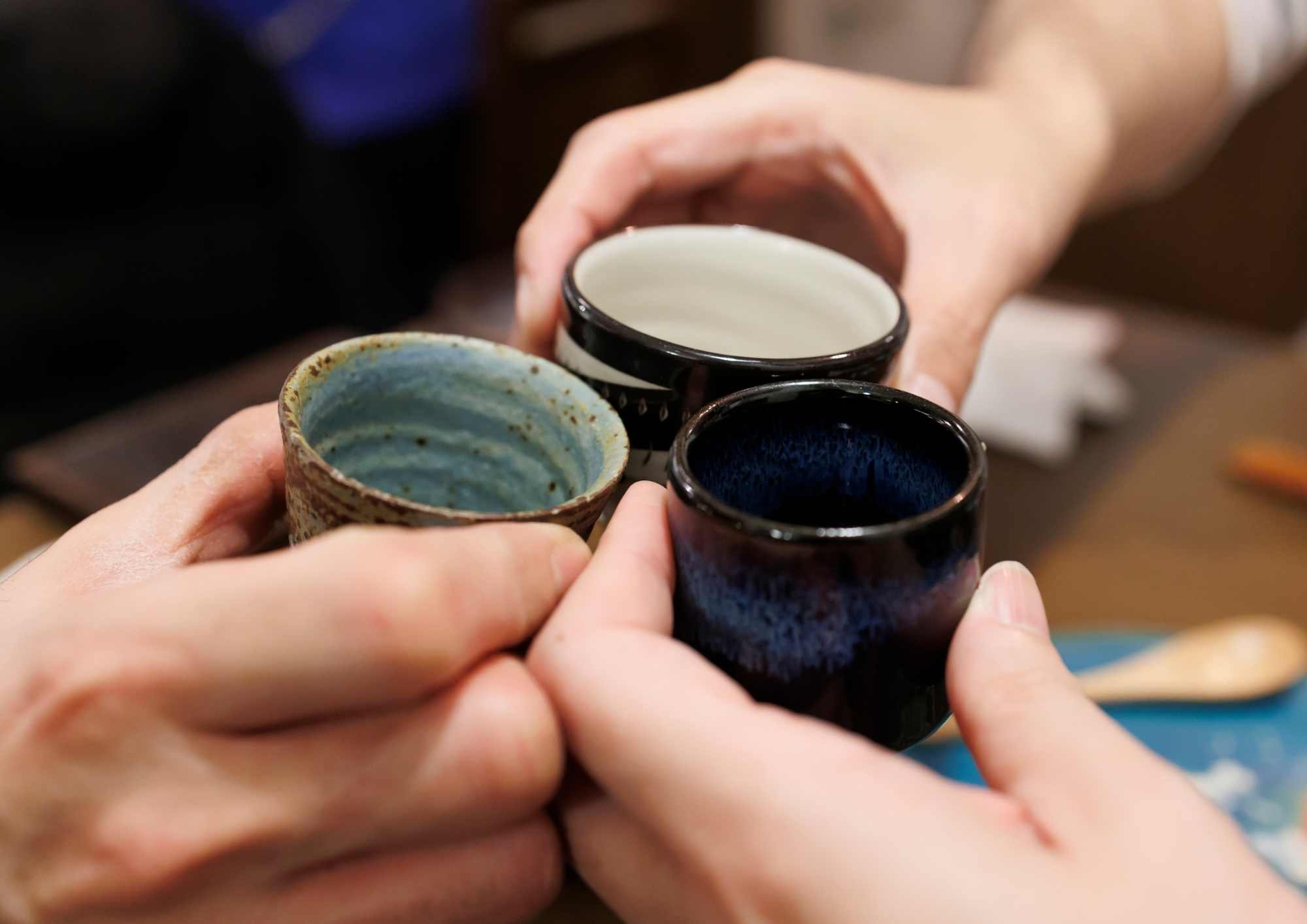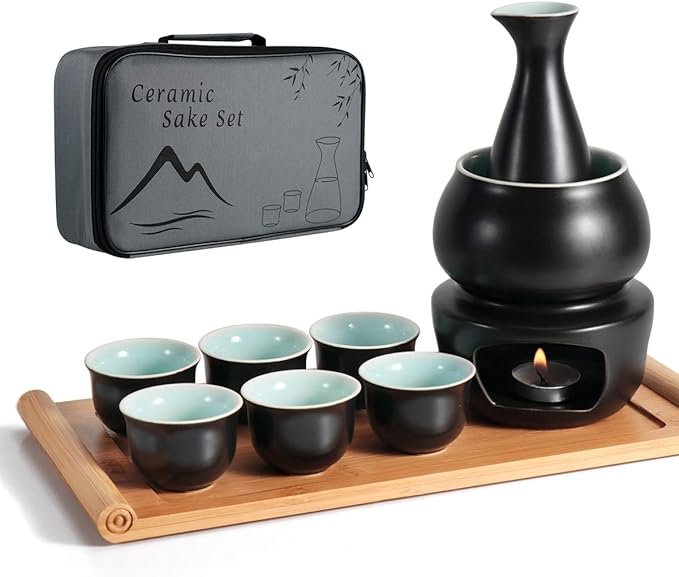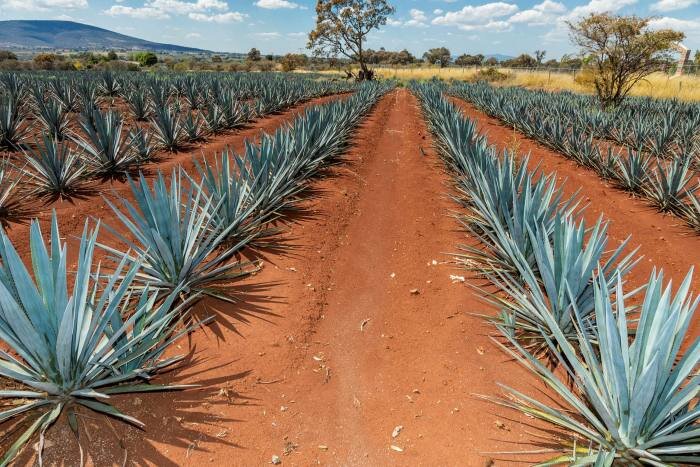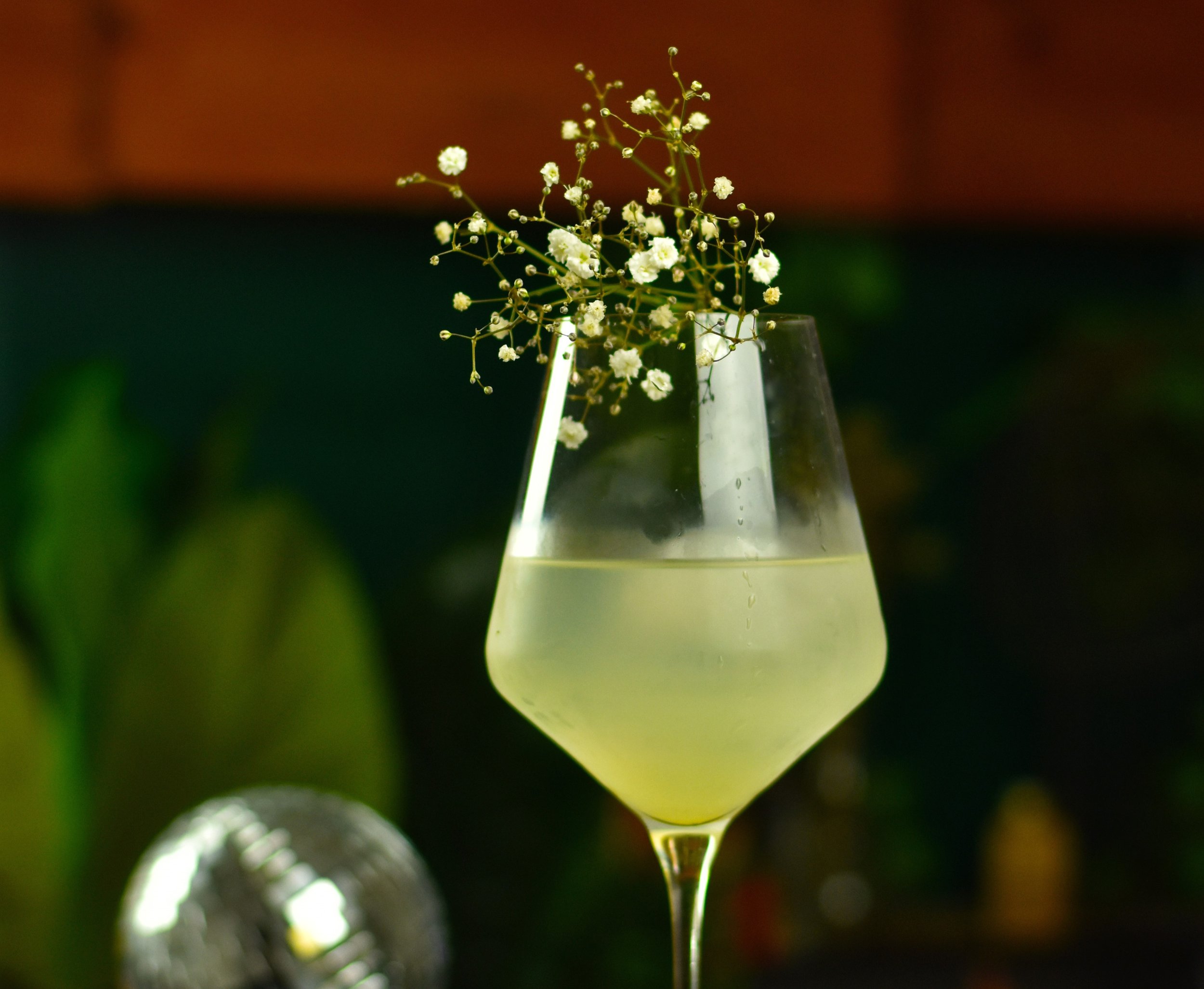What Is Sake?
Welcome, fellow sake enthusiast, to the ultimate guide on this captivating Japanese elixir. As a seasoned bartender with a deep appreciation for the art of crafting and enjoying sake, let's embark on a comprehensive journey through the nuanced world of this beloved libation. Whether you're a novice or a connoisseur, by the end of this guide, you'll be well-versed in the complexities of everything sake and will be fully able to answer the big question - What is Sake.
What is Sake
Definition of Sake
Let's start at the beginning – what exactly is sake? Sake, pronounced "sah-keh" or "sah-kee," transcends being a mere beverage. It's a cultural emblem deeply rooted in Japanese traditions, often gracing ceremonies, celebrations, and daily life.
Why is Sake called Sake?
The word sake in Japanese means any alcoholic beverage. while the beverage called sake in English is usually termed nihonshu (日本酒; meaning 'Japanese alcoholic drink').
“What is Sake” info graph - free to use with credit to this page.
What is Sake Made From
To truly understand sake, we must delve into its ingredients. Sake is an alchemical blend of rice, water, and the mystical Koji mold. The choice of rice, particularly sake rice, plays a pivotal role in shaping the final product.
What is Sake Rice?
Sake rice, a unique cultivar, undergoes an intricate process of milling and polishing, setting the stage for the alchemy of sake brewing. Sake rice is generally not eaten and has been cultivated with the sole purpose of making it perfect for fermentation.
What is Koji?
Koji refers to the cultivated koji mold growing on steamed rice, barley, or various grains. It holds significant importance in the production of traditional Japanese fermented delicacies such as sake, shochu, miso, soy sauce, and vinegar. The enzymes present in koji play a pivotal role in breaking down the starch and protein content of the grains, contributing to the development of flavor compounds in fermented foods.
Brewing Process
Brewing sake is an art form that requires precision and patience. Explore the intricacies of rice milling, fermentation, and pasteurization, each contributing to the layers of complexity found in this elixir.
So, Is Sake Wine?
Referring to sake as rice wine makes sense, as it has a fermentation process similar to that of wine, but with rice. However, Sake is not a wine, beer or liqueur. Sake is in a category of its own. Calling sake “rice wine” would be similar to calling beer “grain wine”. Technically, yes, that is a way to describe it. But you wouldn’t exactly do that, would you?
Types of Sake
Categories based on Rice Milling
Unlock the secrets of sake categories – Junmai, Honjozo, Ginjo, and Daiginjo. Each category unfolds a distinct narrative, offering a spectrum of flavors and characteristics.
Junmai Sake
Characteristics:
Pure Rice Sake: Junmai is known for being pure rice sake, meaning it contains no added alcohol or brewers' alcohol. It relies solely on rice, water, yeast, and koji mold during the brewing process.
Full-Bodied Flavor: With a robust and full-bodied flavor profile, Junmai sake often has a rich, earthy taste. It's a favorite among those who appreciate a more pronounced rice essence.
Honjozo Sake
Characteristics:
Subtle Elegance: Honjozo strikes a balance between tradition and innovation. It includes a small amount of brewers' alcohol, resulting in a lighter and smoother texture compared to Junmai.
Versatile Pairing: This sake variety is versatile when it comes to food pairings. Its subtle flavors complement a wide range of dishes, making it a popular choice for dining.
Ginjo Sake
Characteristics:
Elevated Milling Process: Ginjo takes the brewing process to the next level with a higher degree of rice milling, often around 40-50%. This meticulous milling contributes to a more refined and aromatic sake.
Floral and Fruity Notes: Ginjo sake is celebrated for its delicate and complex flavor profile, featuring floral and fruity notes. It's a go-to choice for those seeking an elegant and aromatic experience.
Daiginjo Sake
Characteristics:
Extensive Rice Milling: Daiginjo represents the pinnacle of rice milling, often with more than 50% of the rice polished away. This results in an exceptionally smooth and refined sake.
Luxurious Complexity: With its luxurious texture and nuanced flavors, Daiginjo is considered a premium sake. It's ideal for savoring on special occasions or when exploring the finer nuances of sake.
Nigori Sake
Characteristics:
Unfiltered Cloudiness: Nigori, or "cloudy" sake, is unfiltered, giving it a milky appearance. This is due to the presence of rice sediment, creating a unique and textured mouthfeel.
Sweet and Creamy: Nigori sake tends to be sweeter and creamier than filtered varieties. It's a delightful choice for those who enjoy a more textured and dessert-like sake.
Sake Grades
Futsushu (Table Sake)
Characteristics:
Everyday Sake: Futsushu, often referred to as table sake, represents the most straightforward and common category. It's a versatile and affordable option, making it suitable for everyday consumption.
Broad Flavor Profile: Futsushu can showcase a diverse flavor profile, ranging from dry to sweet. It caters to a wide audience and is a popular choice for those new to the world of sake.
Tokutei Meishoshu (specially classified sake)
Characteristics:
Premium Designation: Tokutei Meishoshu represents a premium category, with a focus on specific designations and production methods. This grade includes various subcategories that highlight special brewing techniques and ingredients.
Quality Assurance: Sakes falling under this grade adhere to strict regulations, ensuring a higher level of quality and craftsmanship. The designation may include Junmai, Ginjo, Daiginjo, Honjozo, and more.
Flavored Sake
Flavored sake introduces an exciting dimension to the world of traditional Japanese rice wine. These variations go beyond the classic taste, infusing unique and vibrant flavors that cater to diverse palates. Let's delve into the enticing realm of flavored sake.
Yuzu Sake
Characteristics:
Citrus Elegance: Yuzu sake is a delightful fusion of sake and the aromatic essence of yuzu, a Japanese citrus fruit. The result is a refreshing and zesty flavor profile that balances the sweetness of sake with citrusy brightness.
Versatile Enjoyment: Yuzu sake can be enjoyed on its own, over ice, or as a component in cocktails. Its versatility makes it a popular choice for those seeking a lively and invigorating drinking experience. Try it out in a lemon drop martini for the most delicious Japanese twist on a classic cocktail. Think of the uses for Yuzu sake similar to the uses of limoncello.
Umeshu Sake
Characteristics:
Plum Infusion: Umeshu sake, also known as plum wine, features the infusion of ume (Japanese plums) into the sake. This process imparts a sweet and fruity taste, often with hints of tartness.
Diverse Serving Options: Umeshu can be enjoyed straight, on the rocks, or mixed with soda. Its natural sweetness makes it an excellent choice for those who appreciate fruit-infused beverages. Check out the “land of the raising plum” negroni twist here which uses umeshu sake. As a non important note, Umeshu sake is my personal favorite sake.
Lychee Sake
Characteristics:
Exotic Fusion: Lychee sake combines the floral and tropical notes of lychee fruit with the smoothness of sake. The result is an exotic and aromatic profile that adds a touch of sophistication to the traditional rice wine.
Cocktail Potential: Lychee sake serves as a fantastic base for creative cocktails. Its unique flavor profile lends itself well to mixology, allowing for the creation of enticing lychee-infused drinks.
Peach Sake
Characteristics:
Juicy Sweetness: Peach sake introduces the luscious and juicy sweetness of ripe peaches to the sake. This flavor combination results in a harmonious blend that appeals to those with a penchant for fruity and succulent notes.
Ideal for Cocktails: Peach sake can be a star ingredient in sake-based cocktails. Its natural sweetness complements various mixers, making it a versatile choice for inventive drink recipes.
Flavored sake opens up a world of possibilities for those seeking a departure from the traditional. Whether it's the citrusy kick of yuzu, the sweetness of plum, the exotic allure of lychee, the succulence of peach, or the effervescent charm of sake soda, these variations showcase the adaptability and creativity within the realm of sake.
Types of Sake info graph - free to use with proper credit linked back to this page.
What is Sparkling Sake
Sparkling sake introduces a lively and effervescent twist to the traditional world of Japanese rice wine. This delightful variation undergoes a secondary fermentation process, introducing bubbles that elevate the drinking experience. Let's take a closer look at the characteristics and enjoyment of sparkling sake. Think of sparkling sake as the Cremant of Japan.
Production Process
Like sparkling wines, the production of sparkling sake involves a secondary fermentation process. After the initial brewing, a small amount of sugar and yeast is added to the sake before bottling. This extra fermentation in the bottle produces carbon dioxide, resulting in the characteristic bubbles.
Méthode Champenoise: Some premium sparkling sakes follow the traditional method known as Méthode Champenoise, the same technique used in Champagne production. This labor-intensive process contributes to a finer effervescence and enhanced complexity.
Characteristics
Playful Bubbles: The effervescence in sparkling sake adds a playful and refreshing element to the drinking experience. The bubbles dance on the palate, creating a lively and effervescent sensation.
Light and Crisp: Sparkling sake is often characterized by its light and crisp profile. The effervescence lifts the flavors, providing a clean and invigorating taste that can be enjoyed on various occasions.
Aromatic Nuances: The bubbles in sparkling sake help release and accentuate the aromatic nuances present in the sake. This makes it an excellent choice for those who appreciate a fragrant and expressive beverage.
Serving and Enjoyment
Sparkling sake is typically served chilled to maintain its crispness and effervescence. The colder temperature enhances the refreshing quality of the bubbles.
The light and bubbly nature of sparkling sake makes it a versatile pairing option. It complements a variety of dishes, from seafood and sushi to light appetizers, offering a delightful contrast.
The effervescence and celebratory nature of sparkling sake make it a great choice for special occasions. It brings a touch of festivity to toasts and gatherings.
Brands and Varieties
Many sake breweries produce their own versions of sparkling sake, each with its unique characteristics. Some may be dry and crisp, while others might lean towards fruity or floral notes.
Just like traditional sake, sparkling sake benefits from the craftsmanship of skilled brewers. Some premium and artisanal varieties offer connoisseurs an opportunity to explore the nuanced world of sparkling rice wine.
Sparkling sake adds a vivacious and bubbly dimension to the diverse world of Japanese rice wine. Whether enjoyed as a standalone treat or paired with a variety of dishes, sparkling sake brings a sense of celebration to each sip. Cheers to the effervescence and joy found in every bottle of sparkling sake
Understanding Sake Labels
Deciphering sake labels goes beyond aesthetics. Dive into the details, including alcohol content, to make informed choices about your sake adventure.
Sake Alcohol Content
The alcohol content in sake varies, typically ranging from 15% to 20%. Knowing the specifics enhances your appreciation of the brew.
If it’s your first time, I recommend Akashi Sparkling Sake.
How to Drink Sake
Temperature Variations
Sake's versatility extends to temperature preferences. Explore the art of serving it warm (atsukan), at room temperature (jo-on), or chilled (reishu), discovering how each temperature accentuates different facets of the drink.
Glassware, Ceramics, Sake Sets
Choosing the right vessel enhances the sake experience. From traditional ochoko to wine glasses, each option provides a unique perspective on the flavors within.
Traditional Sake Set
Hand Painted Sake Set
Sake Carafe for Warm or Cold Sake
Warm Sake Set
Sake Etiquette
Immerse yourself in the rituals of sake etiquette. Learn the art of pouring for others and the delicate manner of holding the cup, transforming each sip into a ceremonial act.
How Do You Drink Sake?
The age-old question – should you drink sake straight? Absolutely! Savoring it in its pure form allows you to appreciate the intricate tapestry of flavors.
Hot Sake
Indulge in the cozy embrace of hot sake. Discover the nuanced flavors that emerge when sake is gently heated, providing a comforting elixir for any occasion.
If you want to understand the likeness of this compared to wine. Think of it like the difference between having a red wine and a mulled wine. Check out the above set with the candle as a way to slowly heat sake. Otherwise, just pop it in a saucepan till it heats up. It should be at a drinkable temperature, just warm, not boiling.
Sake Questions Answered
What Kind of Alcoholic Drink is Sake?
Sake occupies a unique space between wine and liquor.
Sake Pronunciation
Before indulging, master the art of pronunciation. It's not just a drink; it's SAH-keh, and saying it right adds an extra layer of appreciation.
What Does Sake Taste Like?
Sake can be floral, fruity, or earthy, offering a diverse range of flavor profiles that cater to varying preferences.
Sake Soda
For the adventurous souls, experiment with sake soda for a refreshing effervescence that tantalizes the taste buds if you don’t like drinking sake neat.
Exploring Specific Varieties
Venture beyond the familiar with Ginjo Sake, Sayuri Sake, and the intriguing Black and Gold Sake like Gekkeikan’s “Black & Gold” Junmai. Each variety tells a unique story.
Sake Trends and Innovations
Beyond the Basics
Witness the evolution of sake through craft breweries, microbreweries, and the rising popularity of sake cocktails. Stay on the pulse of innovation for a modern take on this ancient elixir.
Sake Tasting and Food Pairing
A Gastronomic Adventure
Sake tasting is an art in itself. Explore the intricacies of pairing it with traditional sushi, sashimi, and broaden your horizons with unexpected combinations like cheese and charcuterie.
A good idea is to pick up a bottle of sake and make some homemade sushi then have a home sake and sushi night.
Sake Food Pairing
Unleash the full potential of sake by pairing it with an array of foods. From classic Japanese cuisine to global flavors, discover the harmonies that enhance both the sake and the dining experience.
Exploring Sake Beyond the Bar
Where to Buy Sake
Ready to embark on your sake journey? If you’re from the UK, you can pick up sake online from places like amazon, here are my favourites.
Akashi-Tai Shiraume Umeshu Plum Infused Sake
This is Umeshu plum sake, my favorite flavored sake. Great for cocktails, just swap out sweet vermouth in any recipe for this stuff and you’re on to a winner.
Pagoda Brand - Premium Rice Wine
This sake is great tasting and great looking. The perk for trying out this one is even if you decide sake isn’t for you, you get a lovely piece of home decor.
Kubota Manju Junmai Daiginjo
Now if you want to REALLY taste so proper sake, try this. This is a premium sake. One of the best that’s still accessible for 99% of people.
Akashi Tai Tokubetsu Honjozo Sake
Finally we have akashi tai tokubetsu which is a cheaper sake, yet still great to try neat, drink with soda, in highballs, mixed in cocktails or for cooking.
If you’re from the US, check out supermarkets and Japanese stores.
Cooking Sake
Extend your appreciation beyond sipping. Explore the culinary applications of cooking sake.
What is Cooking Sake?
Beyond the bar, cooking sake transforms into a versatile culinary companion, imparting depth and complexity to your dishes. Much like cooking wine, use cheaper sakes to cook with.
Conclusion
And there you have it – the comprehensive guide to the world of sake. Whether you're a seasoned enthusiast or a curious novice, this journey unveils the layers of complexity and richness that make sake a true Japanese treasure. So, let's raise our glasses to the delightful and intricate world of sake. Kanpai!
And if you have any further questions, do comment them below and I will get back to you ASAP!
More Spirit Guides
Search Drinks
Cocktails, Non-alcoholic, Wine, Coffee, Drink guides, Techniques, Fermentation
All Recipes
Hi, I’m Cameron, guv’nor of Smartblend. If you liked this then you’re in luck, I have a bunch more recipes like it. I share only vegetarian and pescatarian food recipes, cocktails, and drink guides with a sprinkling of wellness and mindful drinking. If that sounds like you, then stick around!
Related Recipes
Smartblend is a participant in the Amazon Services LLC Associates Program, an affiliate advertising program designed to provide a means for sites to earn advertising fees by advertising and linking to amazon.co.uk and amazon.com. Smartblend does earn a small commission on goods purchased through the included links. Don't worry, it doesn't cost you any more, but we do appreciate your referral!

















































